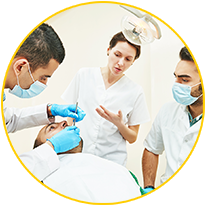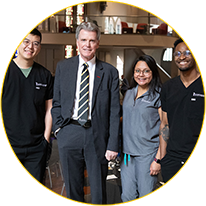contact
Yulvonnda Brown
Office Manager
F 410-706-0865
Course Listing
The Department of Neural and Pain Sciences offers the traditional courses in anatomy, neuroscience, pain and analgesia, pharmacology, and physiology that are part of the curriculum for dental students. A description of those courses follows:
The course in human anatomy is devoted to the study of the structure and function of the body using a regional approach with an emphasis on functional and clinical relevance. It includes the study of the organs and muscles with their relationships, arterial supply, venous and lymphatic drainage, and innervation. Principles of body structure and function are studied with particular emphasis on the head and neck and major organ systems. A strong effort is made to correlate anatomy with other courses in the basic and clinical sciences of the dental curriculum.
The neuroscience course includes a study of neuronal activity and functions ranging from molecular events to neuronal circuitry and neurophysiology. The activities of the nervous system presented include: nociception, discriminative touch and proprioception, special senses, somatic motor control and higher cortical functions. Clinical correlations and therapies are discussed to illustrate the importance of understanding the basis of these functions of the nervous system.
NPSC 521A NEUROSCIENCE OF PAIN ▾
The program of instruction in pain and analgesia is a required course for second year dental students and serves as the basis for translational research conferences for second and third year students. The didactic portion is divided into three sections: the neurobiology of pain, science of acute and chronic pain conditions, and diagnosis and treatment of orofacial pain conditions. This is an intensive course emphasizing the latest theories of mechanisms underlying acute and chronic pain. The translational research conferences emulate a clinical situation in which a patient complains of orofacial pain simultaneously experiencing other medical/dental conditions. Students must differentiate signs/ symptoms leading to differential diagnoses and present a tentative treatment plan all the while emphasizing the underlying neurobiology of pain in diagnoses and treatment. The goal is to have students utilize their basic science knowledge as the foundation for diagnosis and treatment of craniofacial disorders.
Pharmacology is the study of drug mechanisms and drug use in the treatment, diagnosis, and prevention of disease. The foundation of pharmacology is composed of organic chemistry, biochemistry, anatomy, microbiology, and physiology. Because of this, the study of pharmacology usually encompasses aspects of other biological science courses you have already studied.
In this pharmacology course, drugs are considered to be chemicals that may alter both normal cellular function and disease states (therapeutics). This course emphasizes the mechanism of action of drugs, their absorption, distribution, metabolism, and excretion by the body, the FDA-approved uses in medicine and dentistry, their major adverse effects, and other information pertinent to medicine and dentistry. Drug interactions, rationale for use of specific drugs, and drug indications and contraindications are also stressed.
The art of prescription writing will also be taught. Prescription writing represents a summary of the dentist's diagnostic accuracy, knowledge of therapeutics, and ability to communicate instructions to the pharmacist and to the patient as to the proper use of the drug.
Credits - 5
Offered - Fall
NPSC 532P - PHARMACOTHERAPEUTICS ▾
Advanced Pharmacotherapeutics is a clinical pharmacology course presented in the Spring semester of the 3rd year of the curriculum. It consists of several hours of didactic instruction, numerous hours of Blackboard access, and 2 hours of examinations. The course, presented by Dr. Santo, is designed to enhance the dental students’ appreciation of the role of pharmacology when treating dental patients and to provide review material in preparation for the National Boards Part 2.
Credits - 1
Offered - Spring



